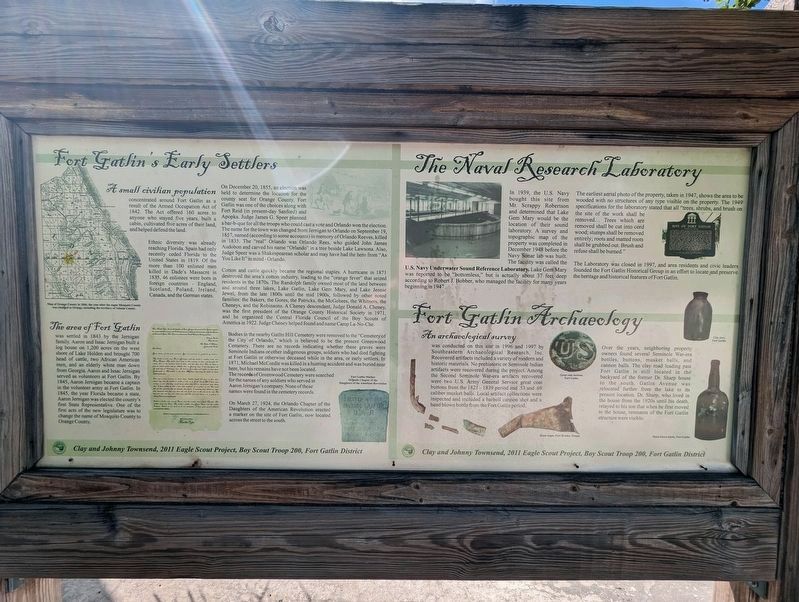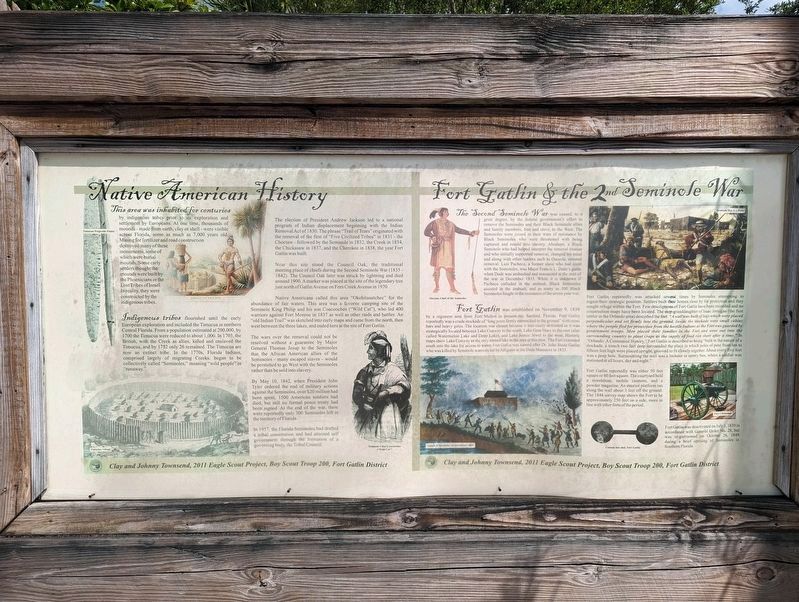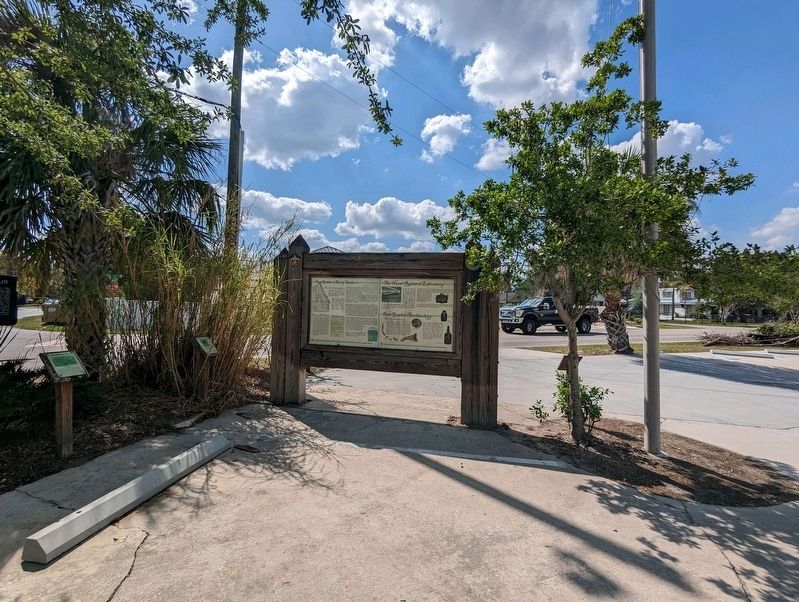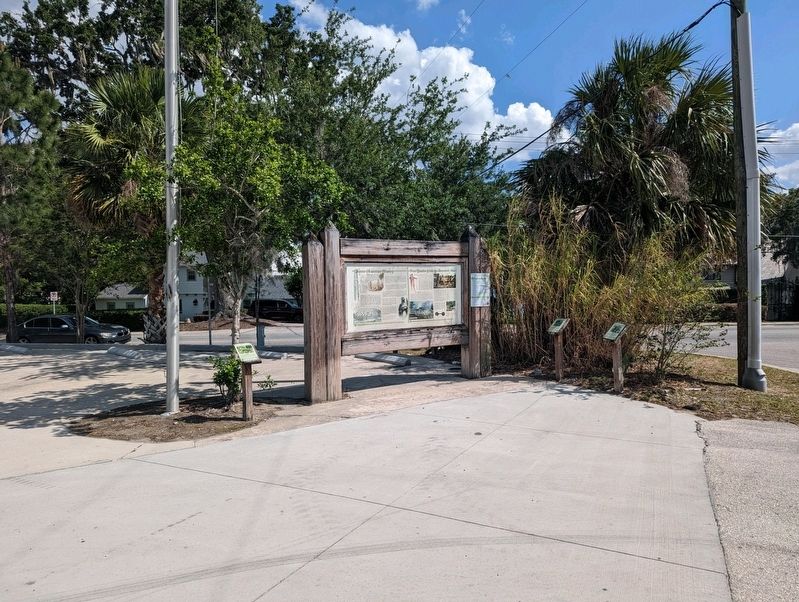Orlando in Orange County, Florida — The American South (South Atlantic)
Fort Gatlin's Early Settlers • Native American History
A small civilian population concentrated around Fort Gatlin as a result of the Armed Occupation Act of 1842. The Act offered 160 acres to anyone who stayed five years, built a cabin, cultivated five acres of their land, and helped defend the land.
Ethnic diversity was already reaching Florida. Spain had only recently ceded Florida to the United State in 1819. Of the more than 100 enlisted men killed in Dade's Massacre in 1835, 46 enlistees were born in foreign countries - England, Scotland, Poland, Ireland, Canada, and the German States.
On December 20, 1855, an election was held to determine the location for the county seat for Orange County. Fort Gatlin was one of the choices along with Fort Reid (in present-day Sanford) and Apopka. Judge James G. Speer planned a bar-b-que for all the troops that could cast a vote and Orlando won the election. The name for the town was changed from Jernigan to Orlando on Septembe 19, 1857, named (according to some accounts) in memory of Orlando Reeves, killed in 1835. The "real" Orlando was Orlando Rees, who guided John James Audobon and carved his name "Orlando" in a tree beside Lake Lawsona. Also, Judge Speer was a Shakespearean scholar and may have had the hero from "As You Like It" in mind-Orlando.
Cotton and cattle quickly became the regional staples. A hurricane in 1871 destroyed the area's cotton industry, leading to the "orange fever" that seized residents in the 1870s. The Randolph family owned most of the land between and around three lakes, Lake Gatlin, Lake Gem Mary, and Lake Jenny Jewel, from the late 1800s until the mid 1900s, followed by other noted families: the Bakers, the Gores, the Patricks, the McGehees, the Whitners, the Cheneys, and the Robinsons. A Cheney descendent, Judge Donald A. Cheney, was the first president of the Orange County Historical Society in 1971, and he organized the Central Florida Council of the Boy Scouts of America in 1922. Judge Cheney helped founded and name Camp La-No_Che.
Bodies in the nearby Gatlin Hill Cemetery were removed to the "Cemetery of the City of Orlando," which is believed to be the present Greenwood Cemetery. There are no records indicating whether these graves were Seminole Indians or other indigenous groups, soldiers who had died fighting at For Gatlin or otherwise deceased while in the area, or early settlers. In 1871, Michael McCordle was killed in a hunting accident and was buried near here, but his remains have not been located. The records of Greenwood Cemetery were searched for the names of any soldiers who served in Aaron Jernigan's company. None of these names were found in the cemetery records.
On March 27, 1924, the Orlando Chapter of the Daughters of the American Revolution erected a marker on the site of Fort Gatlin, now located across the street to the south.
The area of Fort Gatlin was settled in 1843 by the Jernigan family. Aaron and Isaac Jernigan built a log house on 1,200 acres on the west shore of Lake Holden and brought 700 head of cattle, two African American men, and an elderly white man down from Georgia. Aaron and Isaac Jernigan served as volunteers at Fort Gatlin. By 1845, Aaron Jernigan became a captain in the volunteer army at Fort Gatlin. In 1845, the year Florida became a state, Aaron Jernigan was elected to the county's first State Representative. One of the first acts of the new legislature was to change the name of Mosquito County to Orange County.
The Naval Research Laboratory
In 1939, the U.S. Navy bought this site from Mr. Scrappy Robinson and determined that Lake Gem Mary would be the location of their sound laboratory. A survey and topographic map of the property was completed in December 1948 before the Navy Sonar lab was built. The facility was called the U.S. Navy Underwater Sound Reference Laboratory. Lake Gem Mary was reported to be "bottomless," but is actually about 37 feet deep according to Robert J. Bobber, who managed the facility for many years beginning in 1947.
The earliest aerial photo of the property, taken in 1947, shows the area to be wooded with no structures of any type visible on the property. The 1949 specifications for the laboratory stated that all "trees, shrubs and brush on the site of the work shall be removed...Trees which are removed shall be cut into cord wood; stumps shall be removed entirely; roots and matted roots shall be grubbed out. Brush and refuse shall be burned."
The Laboratory was closed in 1997, and area residents and civic leaders founded the Fort Gatlin Historical Group in an effort to locate and preserve the heritage and historical features of Fort Gatlin.
Fort Gatlin Archaeology was conducted on this site in 1996 and 1997 by Southeastern Archaeological Research, Inc. Recovered artifacts included a variety of modern and historic materials. No prehistoric or Seminole Indian artifacts were recovered during the project. Among the Second Seminole War-era artifacts recovered were two U.S. Army General Service great coat buttons from the 1821-1839 period and .53 and .69 caliber musket balls. Local artifact collections were inspected and included a barbell cannon shot and a hand blown bottle from the Fort Gatlin period.
Over the years, neighboring property owners found several Seminole War-era bottles, buttons, musket balls, and cannon balls. The clay road leading past Fort Gatlin is still located in the backyard of the former Dr. Sharp house to the south. Gatlin Avenue was relocated further from the lake to its present location. Dr. Sharp, who lived in the house from the 1920s until his death, relayed to his son that when he first moved to the house, remnants of the Fort Gatlin structure were visible.
Native American History
This area was inhabited for centuries by indigenous tribes prior to its exploration and settlement by Europeans. At one time, thousands of mounds-made from earth, clay or shell-were visible across Florida, some as much as 7,000 year old. Mining for fertilizer and road construction destroyed many of these monuments, some of which were burial mounds. Some early settlers thought the mounds were built by the Phoenicians or the Lost Tribes of Israel. In reality, they were constructed by the indigenous tribes.
Indigenous tribes flourished until the early European exploration and included the Timucua in Northern Central Florida. From a population estimated at 200,000, by 1700 the Timucua were reduced to about 1,000. In 1703, the British, with the Creek as allies, killed and enslaved the Timucua, and by 1752 only 26 remained. The Timucua are now an extinct tribe. In the 1770s, Florida Indians, comprised largely of migrating Creeks, began to be collectively called "Seminoles," meaning "wild people" or "runaway."
The election of Andrew Jackson led to a national program of Indian displacement beginning with the Indian Removal Act of 1830. The phrase "Trail of Tears" originated with the removal of the first of "Five Civilized Tribes" in 1831 - the Choctaw - followed by the Seminole in 1832, the Creek in 1834, the Chickasaw in 1837, and the Cherokee in 1838, the year Fort Gatlin was built.
Near this site stood the Council Oak, the traditional meeting place of chiefs during the Second Seminole War (1835-1842). The Council Oak later was struck by lightning and died around 1900. A marker was placed at the site of the legendary tree just north of Gatlin Avenue on Fern Creek Avenue in 1970.
Native Americans called this area "Okehitanatchee" for the abundance of fair waters. This area was a favorite camping site of the Seminole King Philip and his son Coacoochee ("Wild Cat"), who led 400 warriors against Fort Monroe in 1837 as well as other raids and battles. An "old Indian trail" was sketched into early maps and came from the north, then west between the three lakes, and it ended here at the site of Fort Gatlin.
The wars over the removal could not be resolved without a guarantee by Major General Thomas Jesup to the Seminoles that the African American allies of the Seminoles - many escaped slaves - would be permitted to go West with the Seminoles rather than be sold into slavery.
By May 10, 1842, when President John Tyler ordered the end of military actions against the Seminoles, over $20 million had been spent, 1500 American soldiers had died, but still no formal treaty had been signed. At the end of the war, there were reportedly only 300 Seminoles left in the territory of Florida.
In 1957, the Florida Seminoles had drafted a tribal constitution and had attained self government through the formation of a governing body, the Tribal Council.
Fort Gatlin & the 2nd Seminole War
The Second Seminole War was caused, to a great degree, by the federal government's effort to remove the Seminoles and their Black Seminole allies and family members, free and slave, to the West. The Seminoles were joined in their wars of resistance by Black Seminoles who were threatened with being captured and resold into slavery. Abraham, a Black Seminole who had helped interpret the removal treaties and who initially supported removal, changed his mind and along with other leaders such as Osceola, resisted removal. Luis Pacheco, a former slave who had lived with the Seminoles, was Major Francis L. Dade's guide when Dade was ambushed and massacred at the start of the war in December 1835. While it is unknown if Pacheco colluded with the ambush, as many as 300 Black Seminoles fought in the resistance of the seven-year war.
Fort Gatlin was established on November 9, 1838 by a regiment sent from Fort Mellon in present-day Sanford, Florida. Fort Gatlin reportedly was a crude stockade of "long posts firmly entrenched in the ground" with cross bars and heavy gates. The location was chosen because it was easily defended as it was strategically located between Lake Conway to the south, Lake Gem Mary to the east (also called Watermelon Lake and Deep Lake), and Lake Jennie Jewel to the west. Historic maps show Lake Conway as the only named lake in the area at this time. The fort extended south into the lake for access into the water. Fort Gatlin was named after Dr. John Stade Gatlin who was named by Seminole warriors led by Alligator at the Dade Massacre in 1835.
Fort Gatlin reportedly was attacked several times by Seminoles attempting to regain their strategic position. Settlers built their homes close by for protection and they sought refuge in the Fort. Few descriptions of Fort Gatlin have been recorded and no construction maps have been located. The step-granddaughter of Isaac Jernigan (the first settler in the Orlando area) described the fort: "A wall was built of logs which were placed perpendicular and set firmly into the ground. Inside the stockade were small cabins where the people fled for protection from the hostile Indians as the Fort was guarded by government troops. Men placed their families in the Fort and went out into the surrounding country to plant crops as the supply of food ran short after a time." In "Orlando; A Centennial History," Fort Gatlin is described as being "built in the nature of a stockade, a trench two feet deep surrounded the place in which poles of pine from ten to fifteen feet high were placed upright, grooved to fit closely together. About every five feet was a peep hole. Surmounting the wall was a lookout or sentry box, where a soldier was stationed at all hours, day and night."
Fort Gatlin reportedly was either 50 feet square or 80 feet square. The courtyard held a storehouse, mobile cannons, and a powder magazine. An inferior platform ran along the wall about 3 feet off the ground. The 1844 survey map shows the Fort to be approximately 250 feet on a side, more in line with other forts of the period.
Erected 2011 by Clay and Johnny Townsend, Eagle Scout Project, Boy Scout Troop 200, Fort Gatlin District.
Topics. This historical marker is listed in these topic lists: Anthropology & Archaeology • Forts and Castles • Native Americans • Settlements & Settlers. A significant historical date for this entry is March 27, 1924.
Location. 28° 29.669′ N, 81° 22.042′ W. Marker is in Orlando, Florida, in Orange County. Marker can be reached from the intersection of Summerlin Avenue and Gatlin Avenue, on the right when traveling north. Touch for map. Marker is in this post office area: Orlando FL 32806, United States of America. Touch for directions.
Other nearby markers. At least 8 other markers are within 3 miles of this marker, measured as the crow flies. Site of Fort Gatlin (here, next to this marker); Fort Gatlin 1838 (a few steps from this marker); The Council Oak (approx. half a mile away); Site and Home of Francis Eppes (approx. 0.9 miles away); Welcome to the Pulse Interim Memorial (approx. 1.8 miles away); Conway First Baptist Church/Fort Gatlin (approx. 2.2 miles away); Conway United Methodist Church/Brick Road (approx. 2.3 miles away); St. Mary's Missionary Baptist Church/Datson Dairy (approx. 2.3 miles away). Touch for a list and map of all markers in Orlando.
Credits. This page was last revised on April 22, 2023. It was originally submitted on April 21, 2023, by Mike Wintermantel of Pittsburgh, Pennsylvania. This page has been viewed 273 times since then and 116 times this year. Photos: 1. submitted on April 21, 2023, by Mike Wintermantel of Pittsburgh, Pennsylvania. 2, 3, 4. submitted on April 22, 2023, by Mike Wintermantel of Pittsburgh, Pennsylvania.



